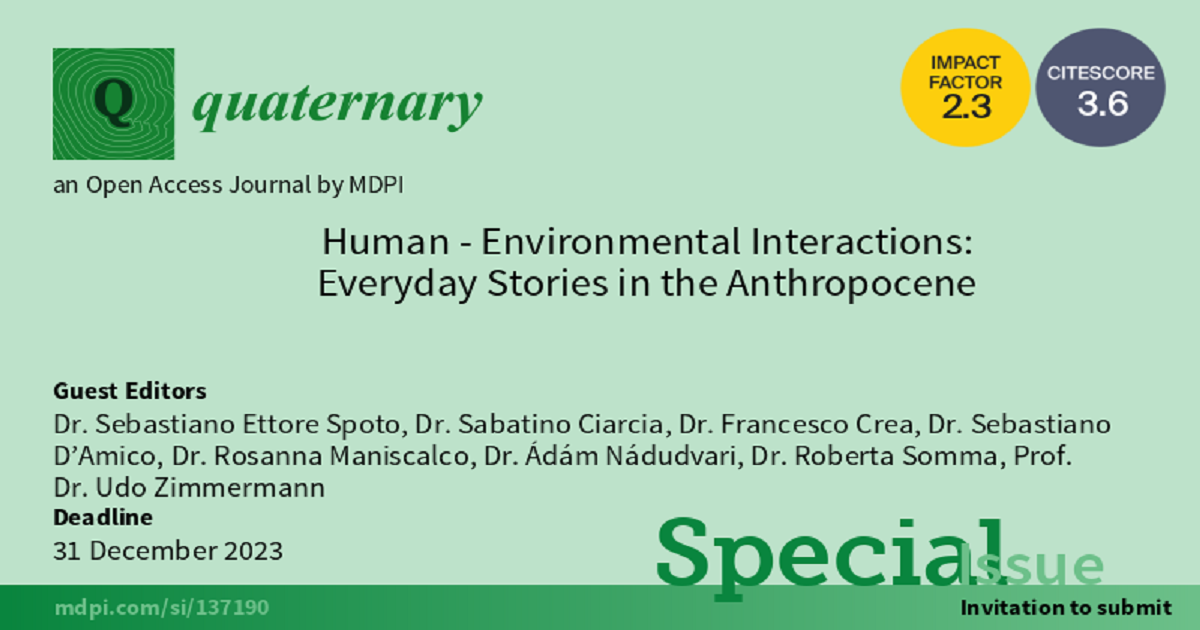Human-Environmental Interactions: Everyday Stories in the Anthropocene
A special issue of Quaternary (ISSN 2571-550X).
Deadline for manuscript submissions: closed (31 December 2023) | Viewed by 3413

Special Issue Editors
Interests: Raman spectroscopy; geochemistry; source-to-sink sedimentary dynamics; environmental mineralogy; mineral pigments; CLIL (Content and Language Integrated Learning) methodology
Special Issues, Collections and Topics in MDPI journals
Interests: stratigraphy; geological mapping; sedimentology; geodynamics; basin analysis; regional geology; sedimentary basins geology; wedge-top basins; lacustrine sediments; southern apennines tectonics; carbonates sediments petrology; sequence stratigraphy; geological processes; radiometric dating; structural geology; geochronology; geotourism; quaternary geology; surficial geology
Special Issues, Collections and Topics in MDPI journals
Interests: analytical chemistry; environmental chemistry; speciation; pollution
Special Issues, Collections and Topics in MDPI journals
Interests: applied geophysics; forensic geosciences; scientific methods applied to cultural heritage; geomatics and remote sensing
Special Issues, Collections and Topics in MDPI journals
Interests: biostratigraphy; tectonics; sequence stratigraphy; geological mapping; sedimentary basins stratigraphy; structural geology; active tectonics; paleoceanography; basin analysis; marine geology; geotourism; sedimentology; exploration geophysics; carbonates; quaternary geology; palaeoecology; paleomagnetism
Special Issues, Collections and Topics in MDPI journals
Interests: environment; water quality rivers; environmental analysis; environmental impact assessment; coal mining; geochemistry; geomorphology; environment protection
Interests: forensic geology; geology; sedimentology; geological mapping; remote sensing; litho-biostratigraphy; structural geology; active tectonics; interplay of tectonics and sedimentation; carbonates; exploration geophysics; quaternary geology; geoheritage; geotourism
Special Issues, Collections and Topics in MDPI journals
Interests: sedimentology; stratigraphy; isotope geochemistry; sedimentary geochemistry; sedimentary basins; geological mapping; field geology; geochronology; regional geology; stable isotope analysis; plate tectonics; basin analysis; radiometric dating; petrographic thin section
Special Issue Information
Dear Colleagues,
Although the term "Anthropocene" has still not been formalized as a new geologic epoch, scholars informally refer to this term to indicate a new geological system in which the intensity of human activity strongly impacted the balances of Earth Systems. Throughout human civilization, people have established and developed communities and societies in locations that allowed them to take advantage of the resources and strategic locations afforded by the action of natural and geological processes. However, the lack of scientific knowledge during the development of both past and modern urbanization and industrialization of our societies created negative effects on the whole environment where the processes that create the aforementioned benefits become hazards. Nonetheless, on the one hand, the exploitation of resources, the increase in emissions of greenhouse gases, and the introduction of pollutants, of both natural and anthropogenic origins, in Earth Systems are leading environmental issues and hazards in which biodiversity, climate, and public health and safety are at stake. On the other hand, due to the acceleration of global population growth and urbanization, human settlements are expected to be increasingly exposed to natural hazards. Global climate changes, intensified natural hazards, and extreme events drive new challenges globally for many countries and regions by affecting millions of people annually.
Accordingly, this Special Issue welcomes research and review papers on environmental sciences, physics, geophysics, biology, chemistry, and earth science applied to the Anthropocene epoch. In this context, particular attention will be given to contributions on, but not restricted to, the following topics:
- Field measurements of natural and artificial pollutants;
- Pollutants and biological effects in humans, animals, and plants;
- Analytical and Spectrometric methods for measurement and control in environmental sciences;
- Aqueous solution behavior of pollutants;
- Analysis of mine waste by physical, geochemical, and geophysical methods;
- Geochemistry, biogeochemistry, and environmental chemistry;
- Environmental mineralogy;
- Environmental, Health, and Urban Physics;
- Ecology, Ecotoxicology, and Environmental Biology;
- Palaeoclimatology, global warming, and climate change;
- Stratigraphy of the Anthropocene;
- Assessment and management of geological- and climate-related risk;
- Earthquakes, tsunamis, volcanic eruptions through the ages;
- Natural and anthropogenic radioactivity;
- Land-use and climate change;
- Micro- and nano-plastic in the environment;
- Geophysics for natural risks;
- Coastal Dynamics;
- Air pollution.
Dr. Sebastiano Ettore Spoto
Dr. Sabatino Ciarcia
Dr. Francesco Crea
Dr. Sebastiano D’Amico
Dr. Rosanna Maniscalco
Dr. Ádám Nádudvari
Dr. Roberta Somma
Prof. Dr. Udo Zimmermann
Guest Editors
Manuscript Submission Information
Manuscripts should be submitted online at www.mdpi.com by registering and logging in to this website. Once you are registered, click here to go to the submission form. Manuscripts can be submitted until the deadline. All submissions that pass pre-check are peer-reviewed. Accepted papers will be published continuously in the journal (as soon as accepted) and will be listed together on the special issue website. Research articles, review articles as well as short communications are invited. For planned papers, a title and short abstract (about 100 words) can be sent to the Editorial Office for announcement on this website.
Submitted manuscripts should not have been published previously, nor be under consideration for publication elsewhere (except conference proceedings papers). All manuscripts are thoroughly refereed through a single-blind peer-review process. A guide for authors and other relevant information for submission of manuscripts is available on the Instructions for Authors page. Quaternary is an international peer-reviewed open access quarterly journal published by MDPI.
Please visit the Instructions for Authors page before submitting a manuscript. The Article Processing Charge (APC) for publication in this open access journal is 1600 CHF (Swiss Francs). Submitted papers should be well formatted and use good English. Authors may use MDPI's English editing service prior to publication or during author revisions.
Benefits of Publishing in a Special Issue
- Ease of navigation: Grouping papers by topic helps scholars navigate broad scope journals more efficiently.
- Greater discoverability: Special Issues support the reach and impact of scientific research. Articles in Special Issues are more discoverable and cited more frequently.
- Expansion of research network: Special Issues facilitate connections among authors, fostering scientific collaborations.
- External promotion: Articles in Special Issues are often promoted through the journal's social media, increasing their visibility.
- e-Book format: Special Issues with more than 10 articles can be published as dedicated e-books, ensuring wide and rapid dissemination.
Further information on MDPI's Special Issue polices can be found here.











